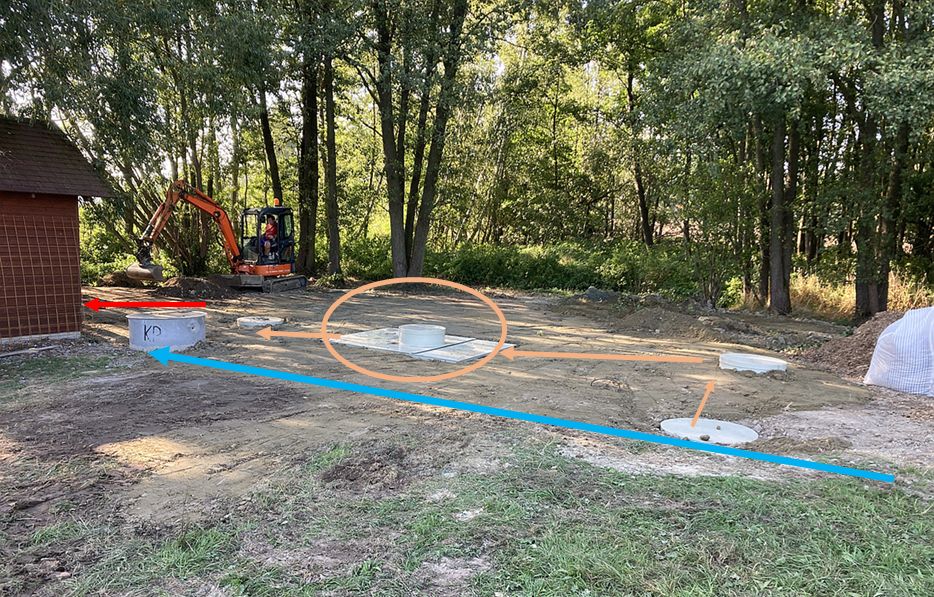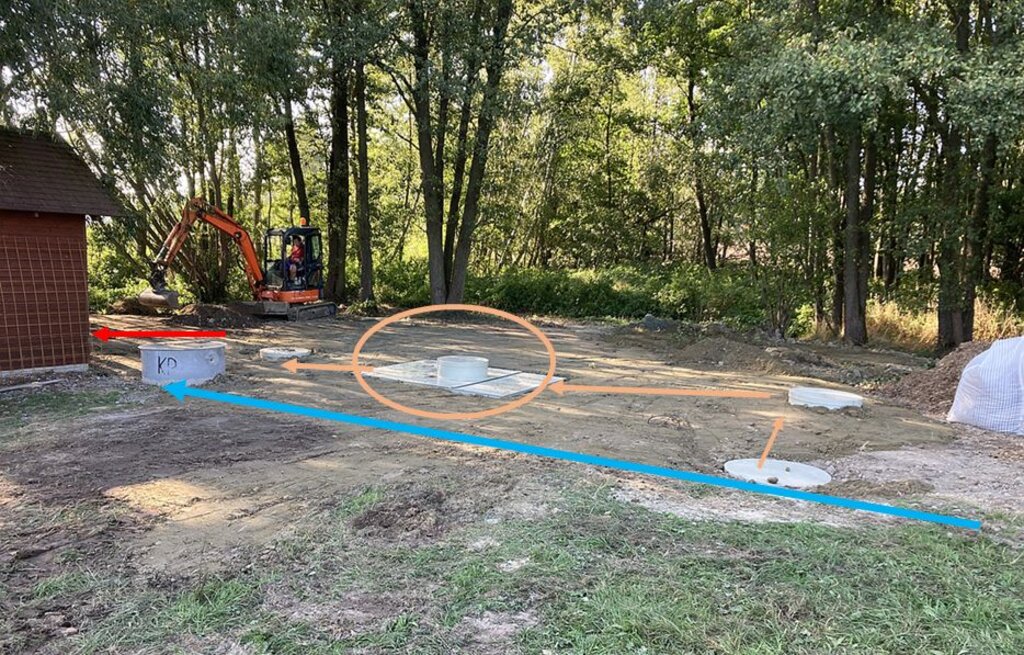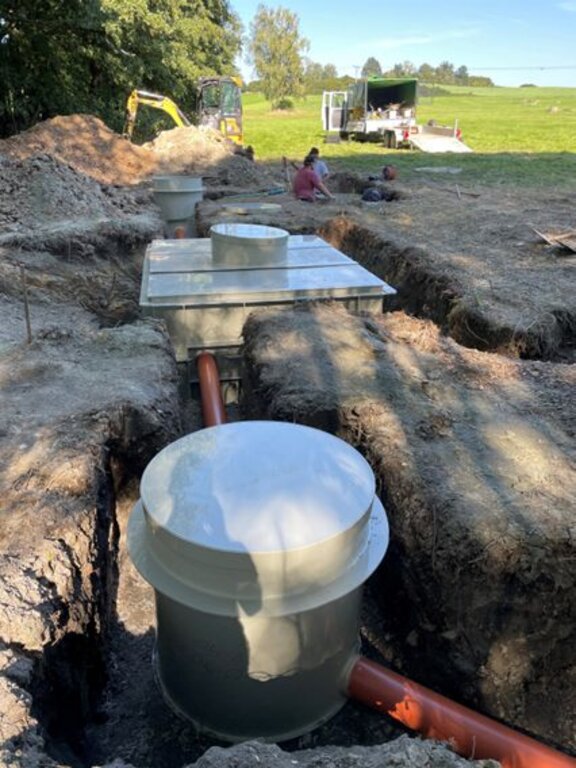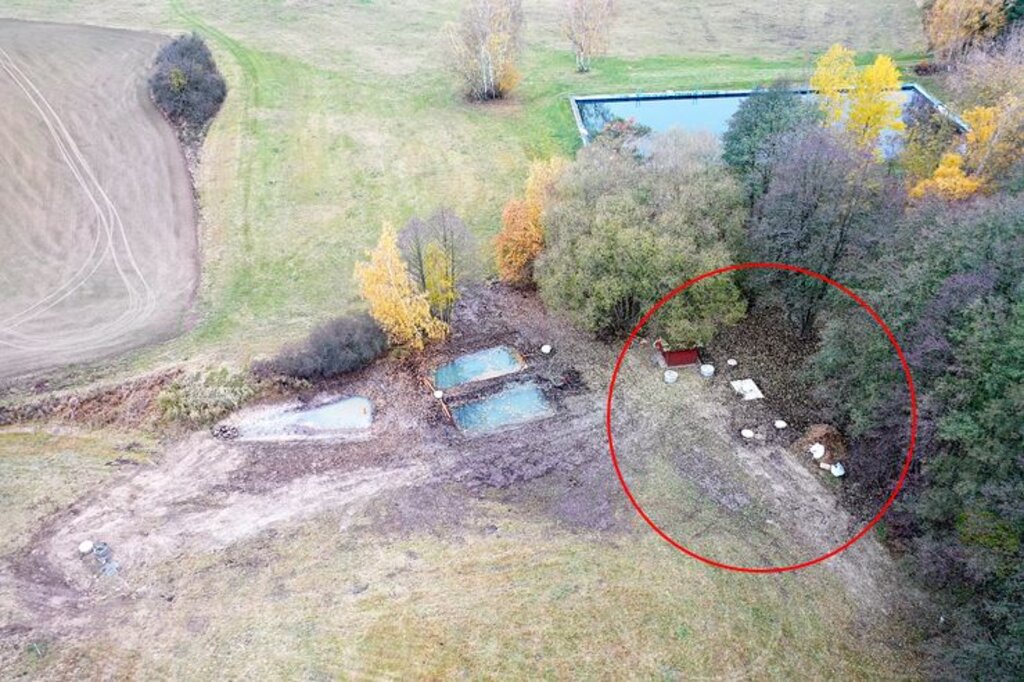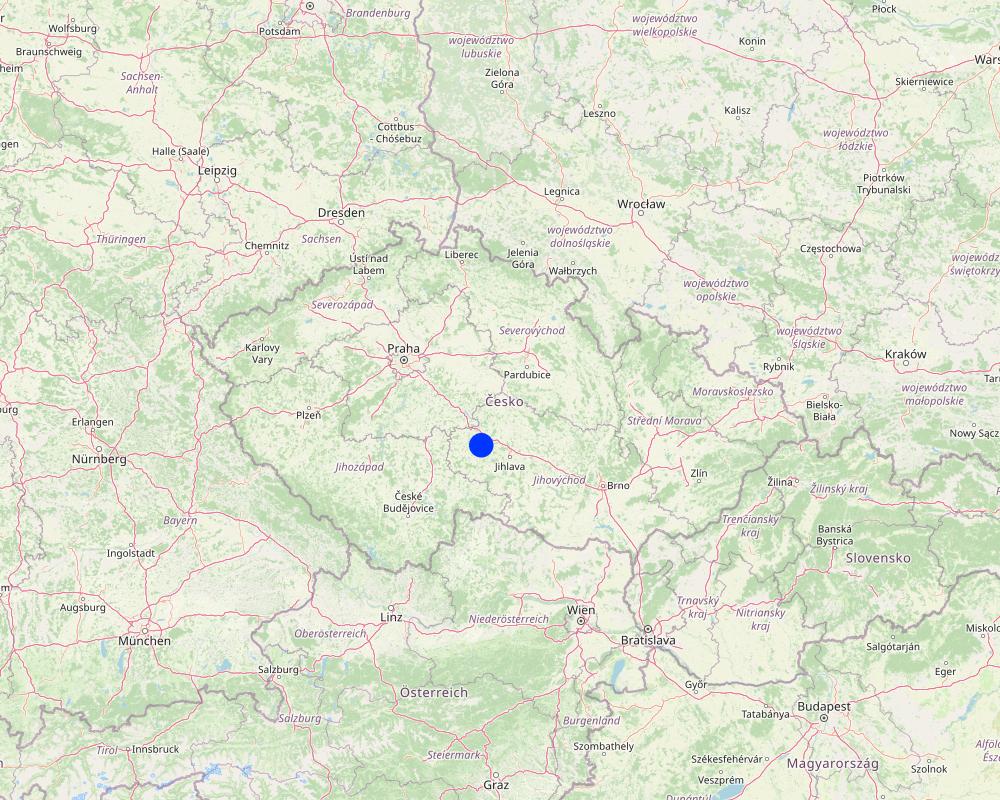Drainage Biofilter [República Checa]
- Creación:
- Actualización:
- Compilador: Antonín Zajíček
- Editor: –
- Revisores: William Critchley, Rima Mekdaschi Studer
Drenážní biofiltr
technologies_6259 - República Checa
Visualizar secciones
Expandir todo Colapsar todos1. Información general
1.2 Detalles de contacto de las personas de referencia e instituciones involucradas en la evaluación y la documentación de la Tecnología
Nombre del proyecto que financió la documentación/ evaluación de la Tecnología (si fuera relevante)
OPtimal strategies to retAIN and re-use water and nutrients in small agricultural catchments across different soil-climatic regions in Europe (OPTAIN)Nombre del proyecto que financió la documentación/ evaluación de la Tecnología (si fuera relevante)
Approaches for design and realization of complex effective measures for tile drained agricultural catchments by land consolidations (QK21010341)Nombre de la(s) institución(es) que facilitaron la documentación/ evaluación de la Tecnología (si fuera relevante)
Research Institute for Soil and Water Conservation (VUMOP) - República Checa1.3 Condiciones referidas al uso de datos documentados mediante WOCAT
El compilador y la/s persona(s) de referencia claves aceptan las condiciones acerca del uso de los datos documentados mediante WOCAT:
Sí
1.4 Declaración de la sostenibilidad de la Tecnología descrita
¿La Tecnología aquí descrita resulta problemática en relación a la degradación de la tierra, de tal forma que no puede considerársela una tecnología sostenible para el manejo de la tierra?
No
Comentarios:
The advantage of the drainage biofilter is that it occupies only a relatively small area and only minimally impedes soil cultivation
1.5 Referencia al (los) Cuestionario(s) de Enfoques MST (documentados usando WOCAT)
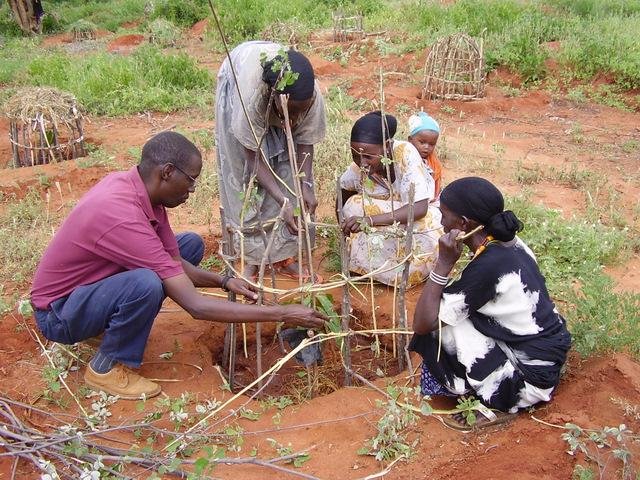
Catchment Approach [Kenia]
A focused approach to integrated land and water management, including soil and water conservation, where the active participation of the villagers - often organised through common interest groups - is central.
- Compilador: James Gatero Njuki

Applied research and knowledge transfer [Marruecos]
Innovative, cross-disciplinary community-based approach for development and transfer of no-till technology at the farm level.
- Compilador: Rachid Mrabet
2. Descripción de la Tecnología MST
2.1 Breve descripción de la Tecnología
Definición de la Tecnología:
Biofilters or “bioreactors” connected to agricultural tile drains are relatively inexpensive and space-saving measures with considerable potential to improve the quality of drainage water.
2.2 Descripción detallada de la Tecnología
Descripción:
A biofilter or “bioreactor” is a relatively small installation used to break down pollutants from drainage water. Its basic function is to allow the passage of drainage water, contaminated with nutrients and pesticides, through a container with pollutant-reducing agents. Bioreactors are usually located at the bottom of agricultural drainage structures on the drains or in connection with drainage outlets. Ideally, the biofilter is located on a site that is no longer part of the cultivated land or is under permanent grassland.
In principle, two biofilter solutions are possible. In the case of low and regular drainage flows, the drainage section is directly replaced by a biofilter. With higher flows and in the case of rapid response of the drainage structure to rainfall-runoff episodes, the biofilter is placed parallel to the outlet drain or is located under the drainage outlet (if ambient conditions allow). Such a design includes a distribution structure (preferably located in a drainage manhole) and a drainage pipe to allow safe bypassing of a portion of the elevated drainage outlet, to maintain the residence time of the water in the biofilter and thus its corresponding efficiency.
The biofilter may be designed as closed or open. A closed biofilter is completely buried and normal tillage can take place. An open biofilter lacks the advantage of an undisturbed terrain but has the advantage of benefitting from plants that enhance the purification of drainage water by bacteria living on their roots.
The installation always consists of a bed or container in which the reducing agent is enclosed, ensuring the isolation of the agent from the surrounding soil and water. In the case of a smaller sized closed biofilter, a plastic container can be used, while in the case of a larger or open design, plastic film can be used as a bed. Various materials can be used as biofilter fillings, or substrates, both individually and in combination. In most cases, the reducing agent is carbonaceous, with denitrification mediated by chemo-organotrophic bacteria.
In terms of N-NO3 removal, the most effective are wood chips, which have a high hydraulic conductivity and a C:N ratio of 30:1 to 300:1. In particular, chips from poplar, pine and larch are suitable. For the removal of pesticides or biopharmaceuticals, then biochar (biochar) and lignite are suitable as natural and readily available materials. A combination of materials can also be used. For example, the addition of biochar to the wood chips will increase the efficiency of the bioreactor in degrading pesticides, or the charge can be combined with an inorganic substrate (sand, vermiculite), which is added to prevent undesirable settling, reduce hydraulic conductivity and at the same time mechanically purify the drainage water.
2.3 Fotografías de la Tecnología
2.5 País/ región/ lugares donde la Tecnología fue aplicada y que se hallan comprendidos por esta evaluación
País:
República Checa
Región/ Estado/ Provincia:
Vysočina region (Highlands Region)
Especifique más el lugar :
Černičí, Dehtáře
Especifique la difusión de la Tecnología:
- aplicada en puntos específicos/ concentrada en un área pequeña
¿El/los sitio(s) de la Tecnología se ubica(n) en un área de protección permanente?
No
Map
×2.6 Fecha de la implementación
Si no se conoce el año preciso, indique la fecha aproximada:
- hace menos de 10 años (recientemente)
2.7 Introducción de la Tecnología
Especifique cómo se introdujo la Tecnología:
- durante experimentos/ investigación
- mediante proyectos/ intervenciones externas
Comentarios (tipo de proyecto, etc.):
Several biofilters have already been implemented as part of research projects, and the development of a standardized, efficient and easy-to-implement solution is currently underway.
3. Clasificación de la Tecnología MST
3.1 Propósito(s) principal(es) de la Tecnología MST
- proteger una cuenca hidrográfica/ áreas corriente abajo – en combinación con otras Tecnologías
- preservar/ mejorar biodiversidad
- reduce diffusive agricultural pollution
3.2 Tipo(s) actuales de uso de la tierra donde se aplica la Tecnología
Mezcla de tipos de uso de tierras dentro de la misma unidad de tierras: :
No

Tierras cultivadas
- Cultivos perennes (no leñosos)
Cultivos perennes (no maderables) - Especifique cultivos:
- cultivos para forraje - pastos
Número de temporadas de cultivo por año:
- 1
¿Se practica el intercultivo?
No
¿Se practica la rotación de cultivos?
No

vías fluviales, masas de agua, humedales
- Líneas de drenaje, vías fluviales
3.3 ¿Cambió el uso de tierras debido a la implementación de la Tecnología?
¿Cambió el uso de tierras debido a la implementación de la Tecnología?
- Sí (Por favor responda las preguntas de abajo referidas al uso de la tierra antes de implementar la Tecnología)

Tierras cultivadas
- Cosecha anual
Cosechas anuales - Especifique cultivos:
- cereales - cebada
- cereales - maíz
- cereales - trigo (invierno)
- cultivos de semillas oleaginosas - girasol, colza, otros
- cultivos de raíces/ tubérculos - patatas
¿Se practica el intercultivo?
Sí
Si respondió que sí, especifique qué cultivos son intercultivados:
In some seasons, spring cereal mix, legume-cereal mix or undersown clover is used as an intercrop
¿Se practica la rotación de cultivos?
Sí
Si fuera el caso, especifique :
five-years or seven-years crop rotation containinng winter cereals, spring cereals, potatoes, red clover, oil seed rape and maize
3.4 Provisión de agua
Provisión de agua para la tierra donde se aplica la Tecnología:
- de secano
3.5 Grupo MST al que pertenece la Tecnología
- manejo de agua superficial (manantial, río, lagos, mar):
- manejo de agua subterránea
3.6 Medidas MST que componen la Tecnología

medidas vegetativas
- V2: Pastos y plantas herbáceas perennes

medidas estructurales
- S11: Otros
3.7 Principales tipos de degradación de la tierra encarados con la Tecnología

degradación del agua
- Hq: reducción de la calidad de subterráneas
- Hq: reducción de la calidad de aguas subterráneas
3.8 Prevención, reducción o restauración de la degradación de la tierra
Especifique la meta de la Tecnología con relación a la degradación de la tierra:
- no aplica
Comentarios:
This measure is primarily aimed at improving water quality.
4. Especificaciones técnicas, actividades de implementación, insumos y costos
4.1 Dibujo técnico de la Tecnología
Especificaciones técnicas (relacionadas al dibujo técnico):
The drawing shows a closed biofilter/bioreactor system, which is built as a bypass of the existing drainage pipe. The measure is looped at the bottom of the drainage system to approximate the recipient.
This system consists mainly of the following features:
1) Drainage water inlet - existing drainage pipe - tile drains
2) Flow control facillity, which is built on top of the existing drainage pipe. The main line structure was excavated, the original ceramic pipe was replaced with a plastic PP pipe and a manhole with an embedded baffle was inserted to allow the water to rise to the required level and subsequently overflow the excess water over the overflow edge. A control element is placed in the manhole to regulate the flow of water into the system.
3) The existing drain, which, once the measures are constructed, serves as a bypass for excess runoff during spring thaw or significant rainfall-runoff episodes.
4) Inflow to the biofilter in the form of a newly constructed pipe.
5) Bed of biofilter - a hardened bed to prevent destruction of the biofilter by shallow groundwater levels and a plastic container for the actual biofilter fill.
6) Biofilter fill. I.n this case a mixture of vermiculite, wood chips and biochar, alternatively wood chips themselves or other materials can be used
7) Purified water outlet from the biofilter
8) Flow control facility, built in drainage manhole, purified water is returned to the existing drainage pipe
9) Drainage outlet
Autor:
Research Institute for Soil and Water Conservation
Fecha:
01/02/2023
4.2 Información general sobre el cálculo de insumos y costos
Especifique cómo se calcularon los costos e insumos:
- por unidad de Tecnología
Especifique unidad:
measure - one system of closed biofilter/bioreactor
otra / moneda nacional (especifique):
EUR
Si fuera relevante, indique la tasa de cambio de dólares americanos a la moneda local (ej. 1 U$ = 79.9 Reales Brasileros): 1 U$ =:
0,92
Indique el costo promedio del salario de trabajo contratado por día:
150
4.3 Actividades de establecimiento
| Actividad | Momento (estación) | |
|---|---|---|
| 1. | Selecting proper place for the measure | Before implementation |
| 2. | Obtaining the consent of the owners and users of the affected land | Before implementation |
| 3. | Project documentation | Before implementation |
| 4. | Water management office permisiond and building permission | Before implementation |
| 5. | Excavation works | Drier period, ideally at the end of the growing season |
| 6. | Biofilter construction | Drier period, ideally at the end of the growing season |
| 7. | Filling the biofilter with substrates | Drier period, ideally at the end of the growing season |
4.4 Costos e insumos necesarios para el establecimiento
| Especifique insumo | Unidad | Cantidad | Costos por unidad | Costos totales por insumo | % de los costos cubiertos por los usuarios de las tierras | |
|---|---|---|---|---|---|---|
| Mano de obra | Project/design | person-days | 5,0 | 200,0 | 1000,0 | 100,0 |
| Mano de obra | Engineering | person-days | 10,0 | 200,0 | 2000,0 | 100,0 |
| Mano de obra | Implementation of the measure | person-days | 6,0 | 150,0 | 900,0 | 100,0 |
| Equipo | Tansport of material | machine-days | 5,0 | 150,0 | 750,0 | 100,0 |
| Equipo | Excavation works | machine-days | 3,0 | 220,0 | 660,0 | 100,0 |
| Material para plantas | grasss seeding | kg | 10,0 | 8,0 | 80,0 | 100,0 |
| Material de construcción | Distribution object (manhole) | piece | 2,0 | 2200,0 | 4400,0 | 100,0 |
| Material de construcción | Container for filling the biofilter | piece | 1,0 | 2400,0 | 2400,0 | 100,0 |
| Material de construcción | Sorbents (vermukulit, biochar, woodchips) | m3 | 3,0 | 440,0 | 1320,0 | 100,0 |
| Material de construcción | drainage pipes and other material | m | 20,0 | 2,0 | 40,0 | 100,0 |
| Costos totales para establecer la Tecnología | 13550,0 | |||||
| Costos totales para establecer la Tecnología en USD | 14728,26 | |||||
Si el usuario de la tierra no cubrió el 100% de los costos, indique quién financió el resto del costo:
co-financing from public sources
Comentarios:
Under certain conditions, owners and users of land, regardless of their legal form, municipalities and other public entities may apply for a subsidy for the implementation of this measure, which is provided by the Ministry of the Environment of the Czech Republic
The subsidy is up to 100 % of the total eligible expenditure, the minimum eligible direct implementation expenditure per project is set at CZK 250 000 ( 10 000 EUR), excluding VAT.
4.5 Actividades de establecimiento/ recurrentes
| Actividad | Momento/ frequencia | |
|---|---|---|
| 1. | Exchange of reducing agent in biofilter | every 5 - 10 years |
| 2. | Cutting the grass aroun the measure | twice a year |
| 3. | Checking and maintenance/repairs | once a year |
4.6 Costos e insumos necesarios para actividades de mantenimiento/ recurrentes (por año)
| Especifique insumo | Unidad | Cantidad | Costos por unidad | Costos totales por insumo | % de los costos cubiertos por los usuarios de las tierras | |
|---|---|---|---|---|---|---|
| Mano de obra | grass chopper | machine days | 1,0 | 100,0 | 100,0 | 100,0 |
| Material para plantas | grasss seed | kg | 10,0 | 8,0 | 80,0 | 100,0 |
| Indique los costos totales para mantenecer la Tecnología | 180,0 | |||||
| Costos totales para mantener la Tecnología en USD | 195,65 | |||||
Comentarios:
It is necessary to replace the sorbent once every 5 years to once every 10 years. The price of sorbents (vermiculite, biochar, woodchips) EUR 1320 for ca 3 cubic meters needed. The price for transportation and switching of old and new sorbents is ca EUR 300.
4.7 Factores más determinantes que afectan los costos:
Describa los factores más determinantes que afectan los costos:
The price of this measure is mostly influenced by its dimensioning for a certain water residence time of the drainage runoff (the above described example is dimensioned for a delay period of about 12 hours at a maximum drainage flow of 0.5 l/s). Another factor is the price of sorbents, where biochar and vermiculite in particular are quite expensive (approximately 250 EUR/m3). Alternatively, woodchips can be used (80 EUR/m3). The price can also be reduced by a simpler construction of the biofilter bed. The minimum price for this measure is estimated at EUR 3 200.
5. Entorno natural y humano
5.1 Clima
Lluvia anual
- < 250 mm
- 251-500 mm
- 501-750 mm
- 751-1,000 mm
- 1,001-1,500 mm
- 1,501-2,000 mm
- 2,001-3,000 mm
- 3,001-4,000 mm
- > 4,000 mm
Especifique el promedio anual de lluvia (si lo conoce), en mm:
666,00
Especificaciones/ comentarios sobre la cantidad de lluvia:
Total precipitation during the vegetation
period ranges between 350 and 450 mm, and in the
winter months between 250 and 300 mm, with a total annual
average of 666 mm.
Indique el nombre de la estación metereológica de referencia considerada:
Košetice, own measurement
Zona agroclimática
- Sub-húmeda
mean average temperature 7,9 °C
5.2 Topografía
Pendientes en promedio:
- plana (0-2 %)
- ligera (3-5%)
- moderada (6-10%)
- ondulada (11-15%)
- accidentada (16-30%)
- empinada (31-60%)
- muy empinada (>60%)
Formaciones telúricas:
- meseta/ planicies
- cordilleras
- laderas montañosas
- laderas de cerro
- pies de monte
- fondo del valle
Zona altitudinal:
- 0-100 m s.n.m.
- 101-500 m s.n.m.
- 501-1,000 m s.n.m
- 1,001-1,500 m s.n.m
- 1,501-2,000 m s.n.m
- 2,001-2,500 m s.n.m
- 2,501-3,000 m s.n.m
- 3,001-4,000 m s.n.m
- > 4,000 m s.n.m
Indique si la Tecnología se aplica específicamente en:
- situaciones convexas
Comentarios y especificaciones adicionales sobre topografía :
The altitude varies between 549.8 and 497 m asl., The substrate is formed by partially
migmatized paragneiss in various degrees of degradation.
Quaternary sediments are represented by slope sands and
loams reaching 1–2 m thickness.
5.3 Suelos
Profundidad promedio del suelo:
- muy superficial (0-20 cm)
- superficial (21-50 cm)
- moderadamente profunda (51-80 cm)
- profunda (81-120 cm)
- muy profunda (>120 cm)
Textura del suelo (capa arable):
- mediana (limosa)
Textura del suelo (> 20 cm debajo de la superficie):
- mediana (limosa)
- fina/ pesada (arcilla)
Materia orgánica de capa arable:
- media (1-3%)
Si se halla disponible, adjunte una descripción completa de los suelos o especifique la información disponible, por ej., tipo de suelo, pH/ acidez de suelo, capacidad de intercambio catiónico, nitrógeno, salinidad, etc. :
The representation of soils
(according to the World Reference Base for Soil Resources
2006) is variable, with Gleyed Cambisols, Gleysols, and
sporadically Histosols. In the recharge area, the soil cover is
more homogenous, with prevailing Modal, Ranker and
Arenic Cambisols.
5.4 Disponibilidad y calidad de agua
Agua subterránea:
< 5 m
Disponibilidad de aguas superficiales:
bueno
Calidad de agua (sin tratar):
solo para uso agrícola (irrigación)
La calidad de agua se refiere a:
agua subterránea y superficial
¿La salinidad del agua es un problema?
No
¿Se está llevando a cabo la inundación del área? :
No
Comentarios y especificaciones adicionales sobre calidad y cantidad de agua:
Water quality is threatened by non-point source (agricultural) pollution, in particular by increased leaching of nitrate nitrogen and pesticides and their metabolites
5.5 Biodiversidad
Diversidad de especies:
- mediana
Diversidad de hábitats:
- mediana
5.6 Las características de los usuarios de la tierra que aplican la Tecnología
Sedentario o nómada:
- Sedentario
Orientación del mercado del sistema de producción:
- comercial/ mercado
Ingresos no agrarios:
- menos del 10% de todos los ingresos
Nivel relativo de riqueza:
- promedio
- rico
Individuos o grupos:
- cooperativa
- empleado (compañía, gobierno)
Nivel de mecanización:
- mecanizado/motorizado
Género:
- mujeres
- hombres
Edad de los usuarios de la tierra:
- jóvenes
- personas de mediana edad
- ancianos
5.7 Área promedio de la tierra usada por usuarios de tierra que aplican la Tecnología
- < 0.5 ha
- 0.5-1 ha
- 1-2 ha
- 2-5 ha
- 5-15 ha
- 15-50 ha
- 50-100 ha
- 100-500 ha
- 500-1,000 ha
- 1,000-10,000 ha
- > 10,000 ha
¿Esto se considera de pequeña, mediana o gran escala (refiriéndose al contexto local)?
- escala mediana
Comentarios:
The Czech Republic is characterised by a significant size of agricultural holdings. During the socialist era (1948-1989), large agricultural cooperatives were established. Today, most agricultural land is still farmed by similar enterprises, whether in the form of cooperatives, limited liability companies or joint stock companies.
5.8 Tenencia de tierra, uso de tierra y derechos de uso de agua
Tenencia de tierra:
- compañía
- comunitaria/ aldea
Derechos de uso de tierra:
- arrendamiento
- individual
Derechos de uso de agua:
- acceso abierto (no organizado)
¿Los derechos del uso de la tierra se basan en un sistema legal tradicional?
No
5.9 Acceso a servicios e infraestructura
salud:
- pobre
- moderado
- bueno
educación:
- pobre
- moderado
- bueno
asistencia técnica:
- pobre
- moderado
- bueno
empleo (ej. fuera de la granja):
- pobre
- moderado
- bueno
mercados:
- pobre
- moderado
- bueno
energía:
- pobre
- moderado
- bueno
caminos y transporte:
- pobre
- moderado
- bueno
agua potable y saneamiento:
- pobre
- moderado
- bueno
servicios financieros:
- pobre
- moderado
- bueno
6. Impactos y comentarios para concluir
6.1 Impactos in situ demostrados por la Tecnología
Impactos ecológicos
Ciclo de agua/ escurrimiento de sedimento
cantidad de agua
Comentarios/ especifique:
Slowing of the drainage runoff will be noticeable especially during normal and lower discharges
calidad de agua
Comentarios/ especifique:
The effects of the measures are particularly positive in terms of reducing nutrient (nitrogen, phosphorus) and pesticide concentrations
6.2 Impactos fuera del sitio demostrados por la Tecnología
contaminación de aguas subterráneas/ de ríos
Comentarios/ especifique:
The effect of biofilter-type measures is particularly pronounced in small intensively drained agricultural catchments where much of the runoff (and pollution) comes from drainage waters
6.3 Exposición y sensibilidad de la Tecnología al cambio climático gradual y a extremos relacionados al clima/ desastres (desde la percepción de los usuarios de tierras)
Otras consecuencias relacionadas al clima
Otras consecuencias relacionadas al clima
| ¿Cómo es que la tecnología soporta esto? | |
|---|---|
| Irregular rainfall distribution and increasing number of runoff episodes | moderadamente |
Comentarios:
A sudden increase in drainage flow during a rainfall-runoff episode may cause a short-term reduction in the effectiveness of the measures, whereby the residence time of water in the biofilter may be reduced and also a portion of the drainage runoff flows untreated through the bypass
6.4 Análisis costo-beneficio
¿Cómo se comparan los beneficios con los costos de establecimiento (desde la perspectiva de los usuarios de tierra)?
Ingresos a corto plazo:
ligeramente negativo
Ingresos a largo plazo:
ligeramente positivo
¿Cómo se comparan los beneficios con los costos de mantenimiento/ recurrentes (desde la perspectiva de los usuarios de tierra)?
Ingresos a corto plazo:
neutral/ balanceado
Ingresos a largo plazo:
neutral/ balanceado
6.5 Adopción de la Tecnología
- casos individuales / experimentales
6.6 Adaptación
¿La tecnología fue modificada recientemente para adaptarse a las condiciones cambiantes?
Sí
otros (especifique):
treating of pesticide pollution
Especifique la adaptación de la Tecnología (diseño, material/ especies, etc.):
The use of biochar and other advanced materials as substrates will enable the use of bioreactors to reduce water pollution from pesticides and their metabolites
6.7 Fuerzas/ ventajas/ oportunidades de la Tecnología
| Fuerzas/ ventajas/ oportunidades desde la perspectiva del usuario de la tierra |
|---|
| Relatively small and cheap measure |
| The measure does not require frequent and costly maintenance |
| Fuerzas/ ventajas/ oportunidades desde la perspectiva del compilador o de otra persona de referencia clave |
|---|
| High efficiency of drainage water treatment measures |
6.8 Debilidades/ desventajas/ riesgos de la Tecnología y formas de sobreponerse a ellos
| Debilidades/ desventajas/ riesgos desde la perspectiva del usuario de la tierra | ¿Cómo sobreponerse a ellas? |
|---|---|
| Difficult to obtain subsidies for construction | Change in subsidy polices |
| Often different owner and user of the land concerned |
| Debilidades/ desventajas/ riesgos desde la perspectiva del compilador o de otra persona de referencia clave | ¿Cómo sobreponerse a ellas? |
|---|---|
| Reduced efficiency during significant rainfall-runoff events | Correct sizing of the measure. |
7. Referencias y vínculos
7.1 Métodos/ fuentes de información
- visitas de campo, encuestas de campo
Long term research of the whole team
- entrevistas con usuarios de tierras
Discussion with several dozen farmers
- entrevistas con especialistas/ expertos en MST
Literature searches of scientific articles
¿Cuándo se compilaron los datos (en el campo)?
2016
7.2 Vínculos a las publicaciones disponibles
Título, autor, año, ISBN:
ZAJÍČEK, A., SYCHRA, L., VYBÍRAL, T., HEJDUK, T., ČMELÍK, M., FUČÍK, P., KAPLICKÁ, M. 2021: Design of the Revitalization measures on the Main drainage facilities and hydrologically related Detailed drainage facilities (In Czech)
¿Dónde se halla disponible? ¿Costo?
https://doi.org/10.3390/w15061247
Título, autor, año, ISBN:
Kvítek, T.; Zajíček, A.; Dostál, T.; Fučík, P.; Krása, J.; Bauer, M.; Jáchymová, B.; Kulhavý, Z.; Pavel, M. Slowing Down Quick Runoff—A New Approach for the Delineation and Assessment of Critical Points, Contributing Areas, and Proposals of Measures to Reduce Non-Point Water Pollution from Agricultural Land. Water 2023, 15, 1247.
¿Dónde se halla disponible? ¿Costo?
https://doi.org/10.3390/w15061247
Título, autor, año, ISBN:
Vrchovecká, S., Asatiani, N., Antoš, V., Wacławek, S., Hrabák, P. (2023): et al. Study of Adsorption Efficiency of Lignite, Biochar, and Polymeric Nanofibers for Veterinary Drugs in WWTP Effluent Water. Water Air Soil Pollut 234, 268.
¿Dónde se halla disponible? ¿Costo?
https://doi.org/10.1007/s11270-023-06281-0
Título, autor, año, ISBN:
Johnson, G. M.,Christianson, R. D., Cooke, R.A. C., Diaz-Garcia, C., Christianson, L. E. 2022. Denitrifying bioreactor woodchip sourcing guidance based on physical and hydraulic properties. ECOLOGICAL ENGINEERING, 184
¿Dónde se halla disponible? ¿Costo?
DOI10.1016/j.ecoleng.2022.106791
Título, autor, año, ISBN:
Christianson, LE et al., 2021. EFFECTIVENESS OF DENITRIFYING BIOREACTORS ON WATER POLLUTANT REDUCTION FROM AGRICULTURAL AREAS,AGRICULTURAL ENGINEERINGAGRICULTURAL ENGINEERING
¿Dónde se halla disponible? ¿Costo?
DOI10.13031/trans.14011
7.3 Vínculos a la información relevante disponible en línea
Título/ descripción:
Zajíček, A., Hejduk, T., Sychra, L., Vybíral, T., Fučík, P. (2022): How to Select a Location and a Design of Measures on Land Drainage – A Case Study from the Czech Republic. Journal of Ecological Engineering 2022, 23(4), 43–57. ISSN 2299–8993.
URL:
https://doi.org/10.12911/22998993/146270
Vínculos y módulos
Expandir todo Colapsar todosVínculos

Catchment Approach [Kenia]
A focused approach to integrated land and water management, including soil and water conservation, where the active participation of the villagers - often organised through common interest groups - is central.
- Compilador: James Gatero Njuki

Applied research and knowledge transfer [Marruecos]
Innovative, cross-disciplinary community-based approach for development and transfer of no-till technology at the farm level.
- Compilador: Rachid Mrabet
Módulos
No se hallaron módulos


